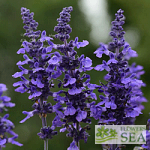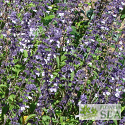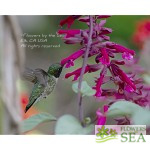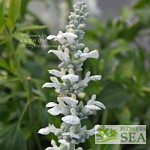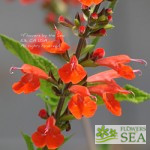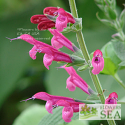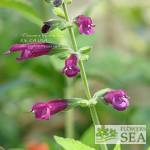 | Flowers by the Sea grows all the hundreds of plants in this catalog, which are mainly the sages (Salvia spp.) in our A to Z list. The green menu banner at the top of this page also shows plants grouped by characteristics, origins and uses. Using our menu, you can search Salvias by topics, such as the color of their flowers, the seasons in which they bloom, their cultural needs for sun and water, the USDA Cold Hardiness Zones in which they thrive and the kinds of sages that appeal to butterflies and hummingbirds. You can also look by origins, which is particularly helpful for native plant gardeners. However, if you know the scientific or common name of the Salvia you want and just need to see if we carry it, the A to Z list is a quick route to that information. Salvia gains its name from the Latin word salvare which means to heal or save. Herbalists have used various species for centuries as folk medicines. Nowadays, medical researchers are studying many sages, which are also gaining popularity as long-blooming landscaping plants that require little fuss. With about 900 flowering species -- including annuals, perennials and shrubs -- Salvia is the largest genus in the mint family (Lamiaceae or Labiatae). Salvias are noted for their mint-family traits of square stems and double-lipped, tubular flowers. Many are intoxicatingly fragrant. The genus contains about 900 species worldwide with its largest concentrations native to the Americas, the Mediterranean, Central Asia (including Turkey) and the Far East. Some plants from other Lamiaceae genuses are included in the A to Z list, because they are so closely related to Salvias that we tend to think of them as true sages. The A to Z list encompasses single representatives of species as well as species for which we offer so many cultivars, such as the Autumn and Mountain Sages (Salvia greggii and S. microphylla spp.), that they have their own subcategory in the Special Salvia Groups part of our index. Sages are endlessly fascinating due to their diversity. They offer a broad array of long-blooming, vibrantly colored flowers. Their leaves range from fuzzy to glossy with shapes and sizes varying from smooth lances tinier than the nail of a little finger to toothed, rumpled foliage broader and far longer than a man's hand. Many are perfect for dry, full-sun gardens while some do well in shady areas with excessive moisture. Sages save many a gardener facing difficult growing conditions. |
(Mister Jules Hybrid Sage) Long, dark, velvety stems contrast dramatically with the deep red flowers of this hybrid, spreading sage from the University of California, Santa Cruz, Arboretum. The parent plants are Mexican Winter Sage (S. holwayi) -- a superior, spreading groundcover or sprawling shrub -- and Cardinal Sage (S. fulgens), which is an upright shrub with large, deep red flowers.
(Mulberry Jam Roseleaf Sage) Magenta flower buds burst into fuzzy, hot pink blossoms in this hybrid sage from the gardens of Betsy Clebsch, author of The New Book of Salvias.
(Mysty Sage) Salvia x ‘Mysty’ is a dwarf version of Mystic Spires Sage and is a dramatic border plant with dark green, corrugated leaves and long blooming flower spikes abundant with deep, violet-blue blossoms.
(Nuevo Leon Hybrid Sage) Imagine tiny, smooth, green leaves and deeper lavender-blue flowers than those of Salvia lycioides x greggii 'San Isidro'. With its midnight purple flowers, Nuevo Leon is a dramatic Salvia greggii hybrid.
(Phyllis' Fancy Sage) The parentage of this lavender-flowered hybrid sage is unknown. However, it may be a cross between Mexican Bush Sage (Salvia leucantha) and Chiapas Sage (S. chiapensis).
(Purple Stem Sage) Deep purple stems and cobalt blue flowers with pronounced white beelines and dusky gray calyxes cause this sage to command attention.
(Scarlet Spires Sage) This is a brilliant cross between the sturdy D'Arcy's Sage (Salvia darcyi) and the beautifully colored 'Raspberry Delight' Littleleaf Sage (Salvia microphylla 'Raspberry Delight').
(Skyscraper Dark Purple Sage) Hummingbirds love Salvia x ‘Skyscraper Dark Purple’, which is brand new for 2019, blooms bountifully in shade, and is outstanding as a container plant.
(Starlight Sage) Add sparkle to your dry garden with the pale pastel flowers of this hybrid of two Southern California native plants often seen growing together in the wild — Black Sage (Salvia mellifera) and White Sage (Salvia apiana). Salvia x 'Starlight' is a shrub that blooms early and long, attracting honeybees but not deer.
(Waverly Sage) A pale pink to lavender blush adds delicate color to the white flowers of Waverly Sage, which are supported by plum-colored calyxes. Its mid-green leaves are lance shaped and veined.
(Wendy's Wish Sage) A new hybrid Salvia from Australia, Wendy's Wish is absolutely spectacular! Quick to bloom, compact and tidy in habit, we believe this to be one of the finest of all Salvia varieties.
(White Flame Sage) Like bright white candle flames, the short vigorously upright flower spikes of petite Salvia x ‘White Flame’ light up flowerbeds.
(Elk Vermilion Tropical Sage) Tall and full of large, orange flowers, Salvia coccinea 'Vermilion' is a clonal variety developed by FBTS.
(Envy Hybrid Sage) A natural hybrid found in Peru and Bolivia, the parentage of this special variety is at this point unknown. The uniquely colored flowers are abundant all season long, and the hummingbirds love it.
(Costa Rica Blue Sage) Although this handsome plant is often listed as an Anise Leaf Sage (Salvia guaranitica), we think it is a hybrid based on differences in its growth pattern and flowering season.
(Dyson's Orangy Pink Hybrid Jame Sage) Many Salvia x jamensis hybrids remind gardeners of sunrise, such as Dyson's Orangy Pink. Light green calyxes faintly striped with red cup its luminous pale salmon pink blossoms with creamy throats.
(Shell Dancer Sage) So many sages combine resilience and loveliness. This includes Salvia 'Shell Dancer', which withstands heat and drought yet has delicate looking blossoms and lush green foliage.
(Tangerine Ballet Hybrid Jame Sage) Soft pinkish-orange flowers with contrasting yellow eyes make this Jame Sage look as tasty as sorbet. Hardy to at least 10 degrees F, Tangerine Ballet is also heat tolerant, drought resistant and long blooming-- all marks of Salvias in the closely related Autumn and Mountain Sage group.



